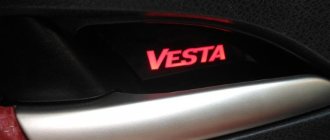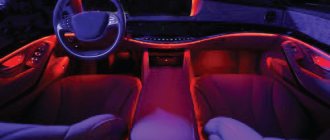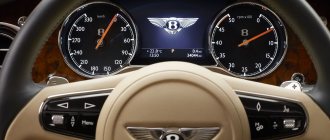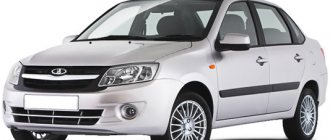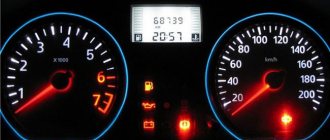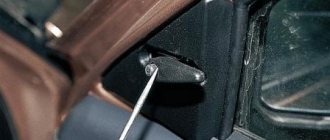In recent years, tuning of passenger cars has become very popular. In the process of its implementation, the body structures are primarily subject to modification, which immediately catch the eye and clearly emphasize the individuality of the car owner.
No less effect can be achieved through internal tuning, one of the varieties of which is the use of lighting for the dashboard, upper part of the cabin and in the footwell area.
Quite often, car interior lighting, including its implementation as atmospheric interior lighting, is often done with your own hands. It is used as a means of increasing the efficiency of using products of the domestic automobile industry, such as, for example, the popular VAZ-2110.
A combination of aesthetics and functionality
The interior lighting of a VAZ as its tuning, done by hand, is usually designed by the developer to solve several problems at the same time.
The first of these tasks in relation to the VAZ-2110 is the creation of an appropriate image, which is achieved by using additional sources of varying brightness and color.
As for the functional role played by car interior lighting, its practical achievement is much more difficult. For the VAZ-2110, the presence of additional light sources means that in the dark, very comfortable conditions are provided not only for the driver, but also for passengers. Let's name just a few of them:
- tuning in the form of lighting helps to quickly find various objects, including small ones, both in the handbag and glove box, and on the seats;
- the so-called polite interior lighting makes getting into the VAZ-2110 much more comfortable, by delaying the turning off of the light after closing the door, and gradually reducing the brightness of the standard light bulb;
- illumination of the lower part of the VAZ-2110 interior allows you to quickly detect objects that have fallen to the floor near the feet;
- Illuminated door handles make it easier for passengers to get in and out.
The list of advantages can be continued if desired.
Installation and connection
The next stage of do-it-yourself lighting of door handles is the installation of LEDs. To do this, you need to remove the inner panel from the door and drill a hole in the handle casing the same size as the LED. Here it is better to start working with a deliberately smaller drill, gradually expanding the hole so as not to accidentally make it too large. It is necessary that the diode fits tightly into the hole made, although it can additionally be placed on glue.
It is best to connect the LED illumination of car handles to the car cigarette lighter. To do everything neatly, you will have to partially disassemble not only the door trim, but also the front part of the car, but it is almost always secured with latches, so this task is not difficult. As a result, the illumination of each door will be made in the form of a chain: two long wires, on one side connected to the cigarette lighter, and on the other, the male terminals are connected to the female terminals of two short wires leading to a diode with a resistor.
If any of the diodes does not work as a result of the operations performed, the polarity of the connection is reversed. The problem is easy to fix - you just need to swap the terminals.
Neither the diode nor the resistor will burn out from incorrect polarity, so you can safely experiment. Correct connection: “+” is supplied through a resistance (resistor).
The same is true for illuminating car door handles with your own hands and from the outside.
Author: Ekaterina
DIY LED lighting installation
In order to get the job done, we will need:
- heat shrink pipe;
- electric wires;
- LED strip and LED lights.
Installation is carried out, as a rule, on the dashboard, in places where lamps and standard lighting elements are located. They can be simply replaced with LEDs if desired. The base of the diode lamp is the same as that of a standard lamp, so replacement is carried out without any difficulties.
Next, you need to install the tape at the bottom in the foot area and around the perimeter of the top of the car. After the necessary measurements, cut off the amount of tape that is needed. Cuts should be made in areas where solder contacts are located.
When measuring, you need to provide some excess wires for reserve. After cutting and soldering to the contacts of the tape, you need to put on the heat-shrinkable tube and heat it with a hair dryer until there is no shrinkage. We process the following fragments in a similar way.
The connection must be made through an RGB block container or in the same way as neon lights. This will ensure that the lights turn on when the car doors are opened.
It is very important to maintain the correct polarity here - this was discussed above
After connecting it yourself, the car door lights will be ready for use - check its operation. If everything is in order, you can be congratulated on your success.
DIY crafts for car enthusiasts
I’ll tell you how to make LED modules with a car logo for interior door handles, with your own hands.
Almost every car has such inserts, but the prices are steep))). Well, I’ll start in order, describing each step, if suddenly someone decides to do the same.
First of all, we needed to make a template. Starting with ordinary thin paper, insert it under the door handle, and trace it with a pen (pencil, felt-tip pen) along the contour inside the handle. You need to try your best
Nobody said that it would work the first time, in my case it took only 3 pieces of paper, the last one would preferably be thicker. Then I needed a white canister; I found a suitable one in the garage that I didn’t need for antifreeze. I traced the template and cut it out with scissors.
Why did I take the canister? It has two advantages: 1- it can be easily cut with a scissor; 2 - will give a scattering effect
This is the basis
The edges can be sharpened if it doesn’t fit, but surprisingly I did everything neatly! We will need to make a sticker. I have a printer and self-adhesive glossy paper, so I had no problems with this. But! If suddenly someone decides to do something like this, then go to any PHOTO STUDIO and tell them that you need to print the inscription KOUP on glossy paper. It will cost you about 10 to 30 rubles. And so, now you need to cut out our sticker. I pasted it with water so that the inscription could be moved.
Then we paint this thing with black paint
I had a can of black gloss lying around in my garage. After drying, I peeled off the sticker, and something was already emerging)
This is what it looks like.
Then I had to spend money for the first time (I bought 1 meter of two-core wire and 10 cm of red LED strip
First, I tried to place the tape behind, and saw that it did not fulfill its properties
You can clearly see how 3 diodes are shining
And without hesitation, he invented a small podium from the remains of canisters
To make the dispersion greater
It turned out to be such a mini lamp. I covered the back of the canister with electrical tape so that there would be no unnecessary glow, leave a window for the inscription
And I glued the lampshade to the base with tape (you can use a heat gun or glue) The podium helped a lot, the light became better than the Korean ones for 40 bucks
Total it took me: - 1 meter of wire (12 rubles) - 10 cm of flying wire - 22 rubles - Canister (0 rubles) - Paint (0 rubles) - Sticker (0 rubles)
Author; Ivan Timoshin Efremov, Tula region
Popular;
- DIY decorative bucket for a tow bar or car bumper
- DIY test pen for 12 volt cars
- How to travel abroad by car.
- Smooth on/off of lights in a car, diagram
- Do-it-yourself interior handle lighting
- Do-it-yourself gearshift knob illumination
- How to make a stethoscope for car diagnostics with your own hands.
- Excellent DIY coffee flavor for your car
How to troubleshoot door switches on a Grant
We invite you to study in detail simple methods for troubleshooting door limit switches on the popular Lada Granta. In practice, every car owner can cope with repairs. So, what can you do when, in the cold season, the door switch stops working correctly:
One of the simplest ways is to treat the surface of the mechanism with a water-repellent specialized liquid. This will help until the air temperature reaches minus 50 degrees. However, such a measure is temporary and rather short-term. It is necessary to remove the anthers from the end switches. It must be remembered that special rubber caps perform a purely protective function, and if you remove them, you will have to more carefully monitor the cleanliness of the mechanism
It is important that the anthers can be removed for a short time when there is severe frost outside, which negatively affects the operation of the device. It is recommended to lubricate rubber surfaces with silicone. However, this method will be useful to you at an air temperature of at least minus 10 degrees. Standard caps can be replaced with analogues
You can use boots from other mechanisms, for example, a good version of Toprun, they are almost identical to the original LADA Granta caps. The most important thing is that such anthers are made of a material that does not lose its elasticity in cold weather. You can install a small spring under the boot. To do this, you can use springs with a diameter of 12-13mm, a length of 18-20mm, with a wire thickness of 1mm. The springs are installed directly on the switch rods under the anthers. If the spring is good, then it will allow the cap to be compressed, and at a temperature of minus 40 degrees it will never let you down.
Illumination of interior car handles
I often read and saw some photos of the interior door handles. I didn’t see it in person, but I really wanted to... In order not to put off meeting the beautiful, and not wanting to overpay for second-hand illuminated pens, I decided to illuminate them myself. LED was chosen as the light. But then I came across the fact that there are no red ones of the required shade on sale. In BMW, all the lighting is coral red. The diodes I came across were either ruby red (like the stars of the Kremlin) or almost orange. There was no middle ground (maybe I was looking poorly...), so I resorted to a trick. I used white light diodes...(?)
I bought regular SMD 5060 flat diodes of warm white color (there were also cold and white moon ones) for 3 volts. I cut out light guides from 4mm plexiglass and polished them on all sides. And to obtain the desired shade, I used a light filter made of red plexiglass, which I subsequently also polished and installed between the diode and the light guide.
Next, square holes were cut out in the handles with a knife.
The light guides fit tightly into the holes. A red stripe filter was soldered to the end of each.
Having attached an LED with soldered wires and resistance to the light filter, I filled the whole thing with hot-melt glue from a gun.
I connected it to all the batteries in the house (9 volts accumulated)
And satisfied with the result, I went to install the handles in the car. This is how they shine in their place. As you can see, the color tone does not differ at all from the original backlight. The only negative is that the light is brighter than I wanted. But I think so. By matting with fine sandpaper you can achieve a decrease in the brightness of the illuminated area and a more uniform beam of light.
That's it. I’ll go look on the Internet for courses on photography in the dark... Since the latest photos do not stand up to any criticism... And if the light was on in the cabin and I could see everything perfectly, then the camera refused to look at the world through my eyes. And although the camera seems to be quite sophisticated (7 years ago it was sold as a semi-professional one), I am unable to figure out this number of settings... As they say: either the skis don’t work, or I’m a *****...
PS Maybe one of the photographers can advise whether it is possible to take decent photos in the dark with my camera... only in Russian, without terms.
Well, as usual, I couldn’t find peace... My work of art was gnawing and tormenting my soul
Installation
Method number 1. Self-installation of LEDs in door handles
.
- Treat the LED with fine sandpaper so that it shines not as a point, but as a scattering light.
- We make a hole in the plastic door handle of the required diameter (for example, 6 mm) using a drill.
- We install the LED in the hole and fix it with glue (for example, hot glue).
The installation process is also shown in the video:
Method number 2. Ready solution
.
- We make a hole in the niche behind the handle.
- We fix the accessory with the inscription “Vesta” inside the door handle.
Thinking through the design
Of course, a car with neon lights looks amazing! And neon interior lighting, when installed correctly, can significantly change the interior of a car. Such lighting looks most advantageous in the dark, as well as on a snowy road in winter.
ADVICE! Think about the color scheme of your lighting in advance. Leading automobile designers, when choosing any type of lighting tuning, recommend choosing it not to match the body, but to contrast it. For example, if you have a blue car, then cherry-colored neon lighting will look much more impressive. Is it difficult to decide on colors? No problem! "Da Vinci's color wheel" can help you.
A car with neon lights looks amazing
Let's start installation
You purchased a brand new neon kit for your car, brought it home and are ready to install. To get started, please read the instructions carefully.
If you decide to install neon lighting for the car interior, then the tape is attached starting from the rear of the car to the trim using superglue or a special adhesive strip included in the kit. Just glue the cord in the right place and connect the batteries to it - car electrics, regular batteries or an inverter for connecting to the cigarette lighter. Connect the wires in the correct sequence: from the + contact of the battery to the place where you plan to install the switch, and connect the negative contact to the body. For a neon cord up to 5 meters long, a 12-volt inverter is sufficient. It can be used to create designs, variations of shapes and colors that are limited only by your imagination.
If, for example, the bottom of a car is chosen as the location for installing the neon, then first you need to mark the fastening. And then:
- Don't forget to buy the necessary tools, silicone for insulation, fastenings (staples, screws, clamps), wires and a transformer.
- Install the tubes according to the intended pattern.
- Now feel free to tackle the electrics. The wire connection is serial. Observe polarity.
- The transformer is secured under the hood with screws. We connect to the battery with high-voltage wires. Then we pull the switch from minus into the interior. All that remains is to connect the wires from the tubes to the high-voltage unit.
Ready! Your car has been completely transformed. Now get ready for the admiring glances of passers-by and other motorists. Good luck on the roads.
Illumination of external and internal door handles of VAZ 2106
So I wanted to do something worthwhile for my classics. I'm posting a report. I only did this on two doors. But this will not interfere with the process since almost everything is identical. At the beginning there are a few photos of how it was done. The report continues in the text...
.
PS. I’ll tell you right away what remains an unsolved problem for me,
- 1. I can’t understand why the relay on the front door sometimes gets stuck, there are no such stickings with the rear door, I have already changed several relays on the front door to study the circumstances, the symptom also appears, after normal operation and switching between white and yellow, then it turns on and off when When opening the door, the illumination of the external handle starts to turn yellow, then everything becomes normal again. Moreover, if you start the car, then no such sticking seems to be noticed.
- 2. Of the minuses, it still failed to scatter the light very well, the diodes are still visible, I think you need to look for a light-scattering film or plastic.
- 3. Yes, I haven’t done it yet because I need to get into the tidy to SIGE, I want to control the interior lighting, I think I read there is such a function, after removing it from the alarm, the light stays on for 30 seconds and then goes out, I think doing this will make the knobs light up for a while.
Scheme:
Connection:
-12 from KN1 (door limit switch) including interior lamps -12 from KN2-KN4 (wire to which the limit switches of other doors are connected) white with a black stripe. +12 white wire (permanent + from the interior lamps) 5-pin (normally closed) relay in accordance with the numbering of the contacts.
Principle of operation.
When a door is opened, LED1-LED3-LED4 on that door light up. On the remaining doors that are not open, LED2 and LED3 are lit. When you open any other doors, LED1-LED3-LED4 light up on them and if LED2 is on, it switches to LED1; the rest LED2 and LED3 are on, etc. for all four doors.
Work process:
Necessary for the manufacture of handles from early VAZ models, where chrome molding was installed in the handles, and the handles were made of foam rubber; in the groove under the molding it is possible to place an LED strip. Modern handles do not have moldings and, accordingly, it will be problematic to place the LED strip. Required handles (Photo 1-2-3). We take the molding out of the handle; it is soft and pulling it out will not be difficult (Photo 4). The molding is covered with a chrome film, somewhat reminiscent of foil; using a stationery knife or any other tools, remove the chrome film from the molding itself (Photo 5).
Once the chrome film has been removed, the molding must be sanded to make its surface more matte. Which will contribute to greater dispersion of light from the LEDs. (Photo 6). To make the backlight “shades” (let’s call them that, since they really represent some kind of lampshades), matte white plastic from some kind of Soviet lamp was used (however, the exact history of this plastic is not known) and transparent white plastic was used, in principle, instead of the latter, you can use any since the reverse part, i.e. the inner part of the lampshade, which will be located in the door handle, is made from it. (Photo 7). The outer matte plastic is 3 mm thick, the inner transparent is 4 mm, and the inner one for the lampshade of the external door handle is 2 mm.
Digression: Plastic can be purchased at advertising agencies, there is a very large selection of both matte and regular transparent plastic, of any thickness, but I did not buy plastic; I made it from scrap material that was at my disposal.
Next, you need to make strips of plastic for the lampshades for the red lampshade, that is, for the lampshade that will look into the interior, I made 9mm strips, the rest of the plastic is 10mm. (Photo 8).
I cut the strips with a router, since I have a router, it turns out more accurately and accurately, compared to sawing plastic, I tried and sawed with a hacksaw and an electric jigsaw with different clean cutting files. It turns out to be complete nonsense, it’s not straight, the plastic pricks and sometimes breaks.
Digression: When cutting plastic, you can use laser cutting of the material; some companies provide such services.
It is necessary to decide on the length of the lampshades themselves; to do this, we mark the place on the handle for the lampshades (see later in the report) and determine the required length of the lampshades, I got 22.5 cm for the large handle and 12.5 cm for the small one. Here you should take into account the cutting ratio of the LED strip, I used SMD 3528 120led, its cutting ratio is 25mm (section 3 diodes). Accordingly, we get 22.5cm for the lampshade (25mm*9sections) and for 12.5cm (25mm*5sections).
Next, you need to make the lampshades themselves. We take a piece of tape of the required length, solder a wire of the required length to it, take into account the length of the wire taking into account the fact that the lamp will be in the handle and the wires from the lamp must be routed through the handle and the door trim, connected to the prepared connector, and then just put on the trim and screw on the inner door handle .
We make the lampshade itself in layers, that is, we get inner transparent plastic, then tape, then outer matte plastic, glue it together, I used silicone, but it’s probably possible to use some other transparent glue to hold this whole “sandwich” together, so to speak. As a result, it will falsely turn out like in (Photos 9 and 10).
Next we make a lampshade for the outer door handle (Photo 11). Lamp made of 3 sections (2 white lights and one orange). I didn’t have any orange diodes, I used plastic from the rear light lens. Output 3 wires from the lampshade (one common + and two – from the white and orange sections of the lampshade.
Let's start marking the handle. I marked the width of the handle 10mm*10mm*10mm (there’s nothing complicated here, everything can be determined by location) (Photo 12). Next, cut out a niche in the handle for the lampshade. (Photo 13). It is necessary to cut accordingly to the thickness of the resulting lampshade. To properly integrate the lampshade into the handle, a metal insert in the handle itself was in the way; I had to sharpen the lampshade itself from the inside (I sharpened the inner plastic).
The lampshade fell into place normally and was on the same plane as the handle. It is necessary to drill a hole from the groove for the lampshade to a place close to the handle mounting bolt, and insert the wires from the lampshade into it, insert the lampshade itself into the groove, my lampshade sat quite tightly, I did not glue it into the inside of the handle.
Digression: To make this insert, it is possible to use profiles for the tape. They have a very large assortment, sizes, etc. but I didn’t buy the profile, it seemed quite expensive: 250 rubles and more for 1 p/m, sold in 2-meter lengths.
Let's start installing the red lampshade, take the prepared handle (Photo 14), use an SMD 3528 120led (red) LED strip, measure the required length of the strip, glue it into the groove from the old molding, put the molding on top of the strip, it is securely fixed due to the grooves (Photo 15) . The prepared strips of matte plastic must be additionally sanded to give a more “matte” surface.
The strip under each handle must be bent along the profile of the handle; I used a hair dryer at about 120-150 degrees. He warmed and bent the plastic to the shape of the handle, bent it from the end of the handle to the beginning, then cut off the excess (Photo 17). The strip sits quite tightly in the groove, but during final installation it was fixed in several places with glue.
We get the finished result.
We begin installing the lampshades in the outer door handle. I want to say right away that the installation was initially planned as in (Photo 21). For testing and experimentation, I had a handle from an old VAZ 2106, 1991. and this handle did not have “spikes” in the handle as in (Photo 18). In (Photo 18) the handle was removed from the current car. So you need to pay attention to the internal shape of the handle.
The presence of these melts subsequently determined the horizontal position of the ceiling and not the side as originally planned. I liked this horizontal arrangement more, since then the lampshade shone downwards as required and illuminated the handle niche better than with a side arrangement. We drill a hole in the handle for the wire, remove the wire from the handle and secure the lampshade with glue. The outer handle is ready.
We screw the handle to the body, connect the wiring to the relay, attach the relay to the handle mounting pin, since it seemed to me that this was a more optimal option. In one step I installed the rear door lock drive. To wire the door, I used a regular wire that is used for laying a dedicated Internet (twisted pair cable), since several wires needed to be connected to the relay, this wire seemed to me the best option and in terms of voltage it holds normally and has 4 twisted pairs, and ideally it can be used to lay 8 wires).
With the front doors, there were no problems with routing the wiring into the door, since there are holes in the doors; we only had to install protective rubber bands. But in the rear doors we had to completely drill holes for wiring.
And the result itself, I shot during the day. (Photo 24)
A combination of aesthetics and functionality
The interior lighting of a VAZ as its tuning, done by hand, is usually designed by the developer to solve several problems at the same time.
The first of these tasks in relation to the VAZ-2110 is the creation of an appropriate image, which is achieved by using additional sources of varying brightness and color.
As for the functional role played by car interior lighting, its practical achievement is much more difficult. For the VAZ-2110, the presence of additional light sources means that in the dark, very comfortable conditions are provided not only for the driver, but also for passengers. Let's name just a few of them:
- tuning in the form of lighting helps to quickly find various objects, including small ones, both in the handbag and glove box, and on the seats;
- the so-called polite interior lighting makes getting into the VAZ-2110 much more comfortable, by delaying the turning off of the light after closing the door, and gradually reducing the brightness of the standard light bulb;
- illumination of the lower part of the VAZ-2110 interior allows you to quickly detect objects that have fallen to the floor near the feet;
- Illuminated door handles make it easier for passengers to get in and out.
The list of advantages can be continued if desired.
Installation on Lada Vesta, XRAY
Required
: standard LED backlight module 8450031185.
Procedure
:
- Make a hole for the backlight module diffuser.
- Fix the LED backlight module.
- Connect to the connector in the doors, which is available on luxury versions, or stretch the wires from the door to the passenger compartment. See connection below.
photo profy55
We similarly modify the Lada XRAY door handles
Photo by walla03
Let there be light
If you are wondering how to make the wheels illuminated, then our instructions will answer it for you. Let's do this job using LEDs, as they are best suited for this purpose. We will not describe installation on all four wheels. Let's look at the whole process using one wheel as an example, and the rest are performed in a similar way:
- To begin, we will need several LED strips, four current stabilizers, corrugated tubes, wires, sealant, glue and wire.
- Then we lift one side of the car and. If desired, the car can be placed on safety stands, since working with a car mounted on a jack is extremely dangerous due to poor stability.
- After removing the wheel, you must thoroughly wash the brake disc casing with gasoline and dry thoroughly.
- After everything has dried, you need to measure the length of the LED strip. This is quite easy to do - just wrap the tape around the casing and cut off the excess. Remember that the tape should only be cut in places specially marked for this purpose. Every three diodes there is a white mark, cut along it (if you cut it in the wrong place, you will simply ruin the tape, since it will no longer work).
- We coat the finished diode strip with glue on the side that will be adjacent to the casing.
- Carefully glue the tape to the casing and let the glue set. After the glue has dried sufficiently, we additionally attach the tape with wire to the brake disc casing.
- The tape is fastened quite tightly. Carefully seal the cut end of the tape using sealant. This is necessary so that moisture does not get into the silicone tape with lamps and ruin all our beauty.
- Wires (plus and minus) are released from the untouched end of our ribbon. We solder the wires to them that will connect to the stabilizer.
- We carefully insulate the soldered wires and place them in a corrugated tube, after which we bring them into the cabin.
- Next, the wires are connected to the stabilizer and lead from it to the headlight wires. If you connect it not to the headlights, but directly to it, then you will have to install an additional switch in the cabin for our lighting. In our case, the illumination of the car wheels will work only when the headlights are on.
Do-it-yourself wheel lighting requires a lot of care and precision on your part. The main components of the backlight are very fragile and can easily fail if mishandled.
Do not forget that when connecting LED strips it is very important to observe the polarity (plus and minus), since if you connect the poles incorrectly, the diodes will not work
If you lower your financial priorities, you can purchase a ready-made kit. Ready-made car wheel lighting has many unique features. For example, sound sensors that respond to musical compositions. As a result, “light music” is produced on wheels. If the lighting kit is multi-colored, then the wheels will play with different colors of the light spectrum. The kits, as a rule, always contain detailed instructions for installing and operating a specific device.
Keep up with auto fashion and let your “steel friend” be the most beautiful, bright and memorable!
One of the easiest and most exciting ways to give your car an unusual look is light tuning. This is a fairly common art that allows you to add zest to any car and make the underbody, radiator grilles and even wheels shine with neon colors. Wheel illumination, as a method of light tuning, always looks very unusual and attracts attention; the contrasting glowing wheels of the car are mesmerizing.
In fact, this effect can be obtained from the primitive installation of LED light equipment in the wheels of a car. For this, an LED strip is used, which should be installed and connected. Next we will look at these processes in more detail.
DIY door handle lighting
When in a dark car interior people begin to fumble with their hands along the trim in search of a handle, the driver can only hope for the efficiency and confident coordination of the movements of his passengers. Such situations happen all the time, and if you have to transport guests after a noisy feast, a country picnic or a barbecue party, the condition of the doors can deteriorate sharply.
Illumination of door handles, done independently and at no special cost, will help correct the situation. This is one of the interior tuning options, which is not a mandatory procedure, but, unlike many other types of finishing, can bring practical benefits.
Main conclusions
Illumination of door handles in the car interior is a convenient and visually attractive tuning option that decorates and increases visibility in a dark interior. There are different options for implementing the method, from simply installing an LED on the back of the case, to using a special panel with a luminous inscription.
Perhaps there are other options, original, successful in decorative terms. We encourage all our readers who have their own experience in this matter to comment on this article and publish their own ideas, lighting options, or share thoughts on improving existing methods.
Previous
LEDsCharacteristics and advantages of Piranha LED
Next
LEDsFeatures, characteristics and maintenance of LED lamps for street lighting
Tape placement
First, we select a place to place the tape. Ideally, it should not be visible. But it should shine well on the rug. Having decided on the installation location, you can proceed to preparing the tape:
- First you need to measure out the desired piece of tape. Please note that it can only be cut in certain places. In this regard, it is better to make it a little shorter than to allow it to sag;
- Next you need to carefully solder small pieces of four-wire wire to the tape;
- We are testing, to do this you need to connect the resulting structure to a power source;
- If everything is in order, then isolate the connections. The easiest way is to use silicone sealant, but you can get by with regular electrical tape;
- We fasten the resulting lighting device into place. To do this, you can use plastic ties or silicone glue.
This work will have to be carried out with any connection method. After this, you need to decide where to connect the backlight. A lot depends on your goals and wishes.
Connection
There are several suitable options for how to make the lighting in your car yourself to ensure an original glow in your legs.
Each motorist will decide for himself how it will be more convenient and easier for him to connect the LED footlights in the car. But there are 3 main options:
- to the lighting of the interior itself;
- through the cigarette lighter;
- from dimensions.
The choice depends on the format in which the driver wants to see the backlight. After all, each scheme provides its own version of when and how the glow will be activated.
Through interior lighting
Some motorists prefer to install footwell lighting in their car by connecting to the main lighting system of the vehicle interior.
This connection method ensures that the backlight will always turn on exactly when the doors are opened or when the car interior lighting is turned on.
If you connect LED lighting for the footwell area in a car through interior lighting, then the light source will need to be connected according to the following algorithm:
- remove the interior lamp;
- connect the wires, observing polarity;
- the white wire usually goes to the plus;
- the negative wire is connected to the red wire;
- the wires are hidden under the interior trim;
- It’s most convenient to stretch them directly along the side post;
- Next, connect the wires of the installed LED strips to each other;
- connect them to a power source;
- check the system for functionality;
- if everything is functioning, perform high-quality insulation;
- return the lampshade to its place.
If you install an additional controller, the light will gradually dim rather than suddenly turn off.
If you are not sure about the polarity of the wiring, use a tester or multimeter. This will make it clear where is the plus and where is the minus. However, the wires may differ in color, depending on the car.
In this way you can connect to functioning interior lighting, but this is not the only option.
Through the cigarette lighter
You can also activate the LED strip from the cigarette lighter, which is done quite often.
By connecting the strip to the cigarette lighter, the light will turn on when the doors are opened.
Not the worst option, since most drivers do not need backlighting while driving. They use it for comfortable getting in and out of the car.
The connection itself is performed according to the following algorithm:
- plus the LED strip connects to the cigarette lighter;
- the minus must be connected to the limit switch on the door;
- the tape wiring is brought out together with the rest of the wires, connecting into a single bundle;
- All contacts are insulated and secured with a tie if necessary.
How exactly to remove and hide the wires depends on the specific car and the driver’s ideas.
Through dimensions
If you connect from the dimensions, then the backlight will function constantly, in parallel with the operation of the dimensions. That is, this is the most relevant option for many, since the system will turn on at night while traveling.
You can connect the plus from any backlight bulb. For example, the glove compartment or dashboard. The minus is thrown onto the body.
If you connect the minus to the door limit switch, then the backlight will turn on provided that the door is open and the lights are on.
Here, each motorist decides for himself how and in what situations he needs the LED strip in his legs to work. Therefore, you can choose different connection options.
By installing the tape in the legs, you can achieve the original appearance of the interior, as well as get some practicality from such a solution. Having chosen the appropriate work option, all that remains is to implement the scheme. Moreover, you can do this yourself, without having a wealth of experience and special specialized education.
Preparatory work
It is not difficult to illuminate car doors with a logo. First, you need to solder a resistor to each LED, and it doesn’t matter which leg. Wires about 20 cm in length are soldered to the other leg of the diode and the free end of the resistor, after which all soldering points are carefully isolated. To do this, you can use cambrics, electrical tape or other materials.
Illuminated car handles
We connect the terminals (“female”) to the short wires, and the “male” terminals will be connected to the long wires, which will then be connected to the car electrical system. The length of such wiring must be determined experimentally, depending on the car model and the installation path you have chosen.
Preparing and connecting wires
Illuminated door handles from the inside.
Now let's get to work. First you need to disassemble the door handle. This is done using appropriate screwdrivers. Now take the LED lamp and remove the plastic housing from it. There you will see pins at the end of the lamp that will need to be soldered to the wiring. But before this, it is advisable to lightly clean the wiring and put small terminals on them. This will make soldering much more convenient for you, and the quality of work will be better.
Related article: Cleaning an old cast iron bathtub
Don’t rush to put plastic plugs on the wires for protection just yet, since in any case you will still have to remove them until the work is completely finished. On the other side of the wires, it is also necessary to lightly strip and put terminals on the ends, but of a larger size.
When doing this kind of work, it is important to consider one important point. As a rule, any door light in a car has two sides: one is the lamp itself that will glow, and the other is the part from which the main power will be supplied to this lamp
So this power can come either directly from the electrical part of the car (usually you need to open the box that is located near the steering wheel) or from the door card, if it has direct power (this is often observed in modern car brands).
In the first case, you need to calculate the length of the wires in advance so that it is completely enough to connect the backlight and at the same time for proper placement, so that in the end the wires do not get in the way under your feet. In the second case, small wires are usually used, since their location does not extend beyond the area of the handle. But still, in both the first and second cases, it is advisable to take long wires, since they can always be shortened.
After this, use an ammeter to check that all wiring is connected correctly. If you don’t understand electricity very well, then it is better to seek advice or direct help from an electrician so that in the future there are no unpleasant problems with a possible short circuit.
What do you need for work?
The first step is to prepare the necessary materials and tools. Will need:
- indicator LEDs with a diameter of 5 mm (any will do, but not too bright so as not to attract constant attention);
- ballast resistors;
- soldering iron and solder with rosin;
- electric drill and drill 5 mm;
- glue gun;
- wires;
- heat-shrink tubing;
- knife for stripping and removing insulation;
- insulating tape;
- Phillips and slotted screwdrivers.
The choice of LEDs is unlimited. You can use conventional indicator samples powered by 3 V; there are also more powerful “piranha” type LEDs that require 12 V to operate. The main selection criterion is the brightness level. Excessive saturation will result in a constant light stimulus being in the field of view and distracting the driver and passengers.
There are ready-made door handle lighting kits that only need to be installed in place and connected to the on-board network. In particular, such elements are produced for the Lada Vesta car and other models.
Ballast resistors are needed to ensure that the onboard voltage drops to the required 3 V. Different values are used, from 430 Ohms to 1.4 kOhms, depending on the type of LED and the required brightness level. The resistor is soldered in series to the positive electrode of the LED (this is a longer leg), the excess length of which is cut off for compactness.
LED lighting elements
Illumination, including in the leg area, can be created by various sources. Without big problems, you can implement all the varieties of known interior lighting options with your own hands.
The accumulated experience clearly demonstrates that such tuning provides the best results when using single and strip semiconductor light sources to illuminate the area around the legs and other places. This is determined by the fact that:
- they do not require high voltage for their operation and are powered from the vehicle’s on-board network;
- due to the low voltage, semiconductor sources are safe to use, even in the area of the feet;
- sources of this type are economical and do not create a serious load on the on-board network of the VAZ-2110;
- LED strips are very flexible and allow you to go around any contour;
- LED strips are available today in a variety of colors.
It is of no small importance that you can make such lighting yourself and connect it to the car network without deep knowledge in the field of electrical engineering
Some design features
When implementing LED interior lighting with your own hands, you must first decide what and how to illuminate.
Regarding the placement of the tape in the interior of the VAZ-2110, lighting can be done everywhere, but it will bring the greatest benefit in the glove box and in the footwell area, and its benefit for the rear seat is much greater. This also includes the illumination of door handles.
As a decorative element, such tuning is best done on air duct grilles; it looks good as illumination of doors with a logo, as well as illumination of car doors along their perimeter.
The type of inclusion of individual lighting elements, including those in the foot area, is set. The simplest option is to permanently connect it to the on-board electrical network. However, the most functional will be a separate, easily accessible switch, which will turn on the decorative lighting of the door illumination with a logo, or the illumination of the foot area, exclusively at night.
It is impossible to give general recommendations for choosing the color of the glow, except for the obvious provision that it should be in harmony with the color scheme of the illuminated components of the VAZ-2110 interior.
Article on the topic: List of cars participating in the 2022 recycling program
How to properly install an LED strip for car interior LED lighting?
Installation of a car with LED strip is carried out according to the standard scheme. First of all, you need to purchase a set of wires, heat shrink tubing, and tape.
It, like individual diodes, is purchased at automobile markets and/or in specialized automobile stores. You should not skimp on the quality and length of the tape; experts advise stocking up on good LEDs. It’s better to buy more diode strip than to realize at the last moment that you don’t have enough.
In addition to interior design, diode strips are actively used to illuminate car wheels.
Step-by-step instructions for diode connection of car interior lighting
Arrangement of lighting in the car, with your own hands, should begin with the instrument panel of the vehicle. To do this, standard equipment is removed: instruments, panel lighting, and diodes are installed. The installation process is very simple, since the diodes have bases similar to factory equipment.
Then you need to determine the installation locations. Many people prefer to mount diodes along the entire perimeter of the ceiling, parallel to the car body pillars. The summer is laid gradually, and the remains can be cut off.
The cut points are clearly visible: they are marked with special membranes. After the procedure, do not forget to clean the ends of the cut and solder them together. We close the connections with bushings and heat them with a hairdryer. In this case, it is better not to use an industrial hair dryer, since there is a high risk of overheating; an alternative is a regular household appliance.
Switching on is carried out similarly to the circuit of neon lamps. You need to be especially careful at this moment and not confuse the polarity points that are indicated on the tapes at the cut points.
Essentially, this is where the workflow ends. There is nothing complicated. Only the installation must be carried out sequentially and be careful about small elements when connecting them.
An important aspect when working is the combination of lighting aesthetics and its functionality, which will be discussed below.
Turn off the backlight in the switch
If there are no other ways to get rid of the flickering lamp lamp, you will need to completely turn off the LED or neon lighting on the switch. Let's look at how to do it yourself and what are the main stages of this procedure.
Preparatory stage
For those who have never installed switches or done electrical work, it is recommended that you carefully consider your actions. Pre-requisite:
- Disconnect the general power supply in the apartment/house from the switchboard switch (by checking its absence with an electrical probe or an indicator screwdriver).
- Prepare a set of necessary tools (mostly a flat-tip screwdriver).
Operating principle of the lighting device
To create illumination, an LED or neon bulb is introduced into the switch circuit parallel to the main contacts. The disconnected chandelier base circuit allows electrical current to reach the switch lighting system. Turned on, on the contrary, leads to disconnection of its power supply. The mechanism of action is based on the difference in resistance between the lamp and the additional light source.
The current passing through the switch LED is clearly not enough to heat the filament of the incandescent light bulb. However, if the chandelier contains an energy-saving lamp or an ice element, then a driver system is used that can operate on low current. Due to the latter, the semiconductor crystal may begin to blink due to the gradual accumulation of potential in the resistor and its periodic release.
What turns on the light
All LEDs and fluorescent lamps operate on direct current. Therefore, at the beginning of their case, a special driver is installed, which includes two required elements:
- Diode bridge – AC to DC converter.
- An electrolytic capacitor is a smoother for voltage pulse dips.
The latter is the main culprit for spontaneous turning on of the light. The fact is that, although weak, current passes through the backlight system - it is impossible to turn it off (only if you completely remove this parallel circuit) - and this is quite enough for the capacitor to accumulate charge. When its potential reaches a predetermined value, a discharge occurs - the light bulb flashes. Although such an event occurs fragmentarily, it nevertheless worsens the life of the lamp, especially gas-discharge ones. In addition, this reduces the comfort of a person’s stay in such a room.
